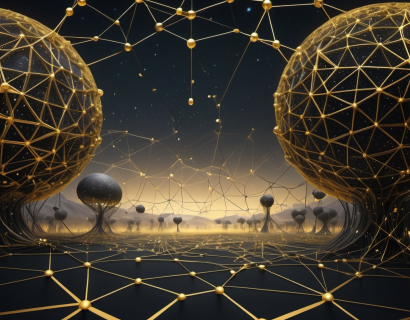Decentralized Excellence: Harnessing Crypto and AI for Next-Gen Digital Transformation
The digital landscape is undergoing a profound transformation, driven by the convergence of two revolutionary technologies: cryptocurrency and artificial intelligence (AI). This synergy is giving birth to a new era of decentralized applications and AI-powered services, promising to redefine user experiences and unlock unprecedented possibilities. This article delves into the intricate relationship between these technologies, exploring how they are merging to create a more secure, efficient, and user-centric digital environment.
The Rise of Decentralized Technologies
Decentralization has been a buzzword in the tech world for several years, but its true potential is only now being realized. Traditional centralized systems, while efficient in certain aspects, are vulnerable to single points of failure, censorship, and data breaches. Decentralized technologies, on the other hand, distribute control and data across a network, enhancing security and resilience. Blockchain, the foundational technology behind cryptocurrencies, is the cornerstone of this decentralization movement.
Blockchain's inherent properties, such as transparency, immutability, and decentralization, make it an ideal platform for building trustless systems. These systems do not rely on intermediaries, reducing costs and increasing efficiency. The application of blockchain extends far beyond cryptocurrencies, encompassing supply chain management, identity verification, and smart contracts, among others.
AI: The Intelligence Backbone
Artificial intelligence, particularly machine learning and deep learning, has advanced rapidly, enabling machines to perform tasks that traditionally required human intervention. AI's capabilities range from natural language processing and image recognition to predictive analytics and autonomous systems. When combined with the transparency and security of blockchain, AI can operate in a more trustworthy and efficient manner.
AI algorithms can analyze vast amounts of data stored on blockchain networks, providing insights and making decisions with minimal human oversight. This synergy not only enhances the functionality of decentralized applications but also ensures that the data used is secure and tamper-proof. The integration of AI in decentralized systems paves the way for smarter, more autonomous digital services.
Decentralized Applications (DApps): The New Frontier
Decentralized applications, or DApps, are the vanguard of the new digital landscape. Unlike traditional web applications, DApps run on a blockchain network, ensuring that data and control are distributed among users rather than centralized servers. This decentralization brings several advantages:
- Enhanced Security: DApps are less vulnerable to hacks and data breaches due to their distributed nature.
- User Sovereignty: Users have full control over their data and assets, without intermediaries dictating terms.
- Transparency: All transactions and interactions are recorded on the blockchain, providing a clear and verifiable audit trail.
- Interoperability: DApps can seamlessly interact with other blockchain-based services, fostering a more connected ecosystem.
One of the most significant applications of DApps is in the realm of finance, known as Decentralized Finance (DeFi). DeFi platforms offer a range of financial services, including lending, borrowing, trading, and insurance, all without traditional financial intermediaries. AI enhances DeFi by providing sophisticated risk assessment, fraud detection, and personalized financial advice, making these services more accessible and reliable.
AI-Powered Enhancements in DApps
The integration of AI in DApps is not just about adding another layer of technology; it's about creating intelligent, adaptive, and user-friendly services. Here are some ways AI is transforming DApps:
Personalization
AI algorithms can analyze user behavior and preferences to offer personalized experiences. In a DApp, this could mean tailored recommendations, customized interfaces, and context-aware services. For instance, a decentralized social media platform could use AI to curate content based on a user's interests and interactions, enhancing engagementand user satisfaction.
Automation and Efficiency
Smart contracts, the backbone of DApps, can be augmented with AI to automate complex processes more intelligently. AI can execute conditional logic and make decisions based on real-time data, reducing the need for manual intervention. This is particularly useful in supply chain management, where AI can predict demand, optimize inventory, and automate payments, all within a decentralized framework.
Enhanced Security and Fraud Detection
AI's ability to detect patterns and anomalies makes it an invaluable tool for enhancing the security of DApps. By continuously monitoring transactions and user activities, AI can identify and mitigate fraudulent behavior in real-time. This is crucial for maintaining trust and integrity in decentralized systems, where the absence of central authorities makes security paramount.
Predictive Analytics
AI-driven predictive analytics can provide insights that drive better decision-making in DApps. For example, in a decentralized marketplace, AI can analyze market trends, user behavior, and economic indicators to forecast demand and optimize pricing. This not only benefits traders and sellers but also contributes to the overall stability and efficiency of the platform.
Challenges and Considerations
While the potential of combining cryptocurrency and AI is immense, there are several challenges and considerations that must be addressed:
Scalability
Blockchain networks, especially those using proof-of-work consensus mechanisms, face scalability issues. High transaction fees and slow processing times can hinder the widespread adoption of DApps. Layer 2 solutions and more efficient consensus algorithms are being developed to address these concerns, but scalability remains a critical challenge.
Regulatory Uncertainty
The regulatory landscape for cryptocurrencies and blockchain technologies is still evolving. DApps that involve financial services must navigate a complex web of regulations, which can vary significantly across jurisdictions. Ensuring compliance while maintaining the decentralized ethos is a delicate balance.
User Adoption
For DApps to thrive, they need widespread user adoption. However, the technical complexity of blockchain and AI can be a barrier for many users. Simplifying user interfaces and providing intuitive onboarding processes are essential to making these technologies accessible to a broader audience.
Interoperability
Interoperability between different blockchain platforms and DApps is crucial for creating a seamless user experience. Standardization efforts and cross-chain solutions are necessary to enable seamless interaction and data exchange across diverse ecosystems.
Future Prospects
The future of digital transformation through the synergy of cryptocurrency and AI is bright. As technology continues to evolve, we can expect more i



